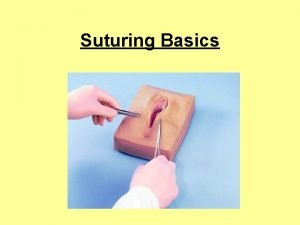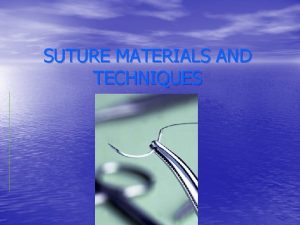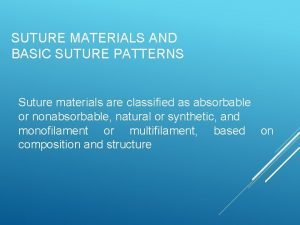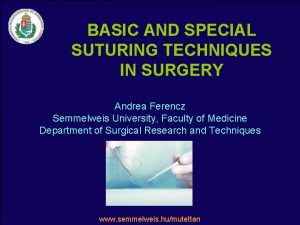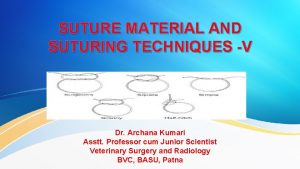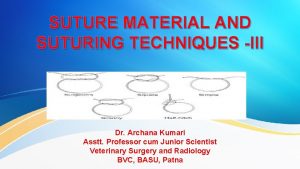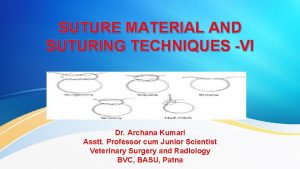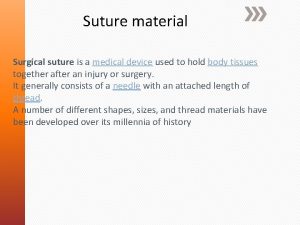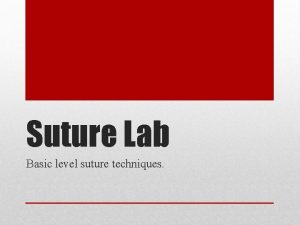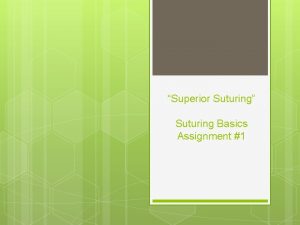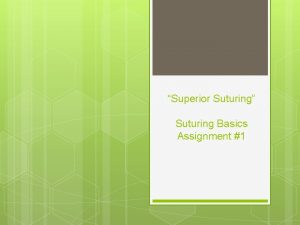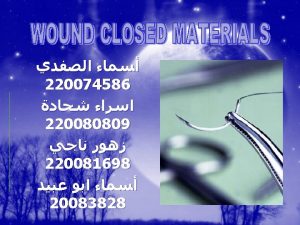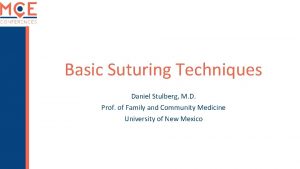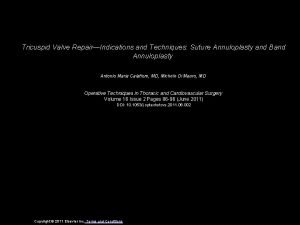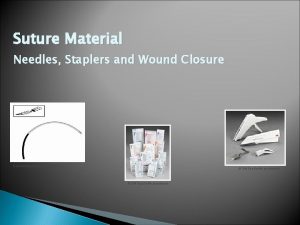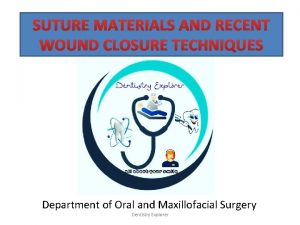SUTURE MATERIAL AND SUTURING TECHNIQUES IV Dr Archana



















- Slides: 19

SUTURE MATERIAL AND SUTURING TECHNIQUES -IV Dr. Archana Kumari Asstt. Professor cum Junior Scientist Veterinary Surgery and Radiology BVC, BASU, Patna

SUTURE MATERIAL

Polydioxanone • It is synthetic monofilament polymer of paradioxanone. • It is sterlised by by ethylene polyglactin 910. • It is absorbed by hydrolysis • Absorption time 91 to 182 days. • On relative basis catgut loses its strength on 7 day, polyglactin at 10 -19 th day and polydioxanone at 20 th day.

Polydioxanone

Non absorbable (Organic suture material) Silk: • Obatined from the cocoon of the silk worm. • Dyed with the vegetable dye. • Its natural capillarity is decreased by treating it with oil, waxor silicone • And it is available as monofilament and braided multifilament. • Sterlised by autoclaving, binds with gammaglobulin leads to acute inflammation may cause ulceration in the GIT. • May act as nidus for calculus formation in the urinary bladder and gall bladder. Cotton: • Less tissue reaction than silk. • Capillary in action Silk worm gut: • It is smooth , strong , non capillary and useful for cutaneous suture. • It is available in fine , medium, and coarse size 30 to 40 cm length

Silk

• • Horse hair : It is cheap , non-capillary , flexible and is easily sterlised. It causes little tissue reaction. Linen: It is capillary in nature and produces more tissue reaction than cotton and silk. Umblical Tape: Cotton tape suture is about 1/4 cm wide and most often used to tie the umblical cord of the new born or as vulvar suture in cases of prolpse of vagina or uterus. • Dermal suture : • Non absorbable silk coated with tanned gelatin or other protein substances.

Inorganic suture material Mettalic suture : • Wire of different metals like tatntalum , silver , copper, aluminium, vitallium(stainless steel). Metal clips (wound clips): • They hold the skin in opposition over flat surfaces. • They causes less scarring. Pin suture : • Ordinary pins can be used for keeping the skin edges together. Wire mesh: • Tantalum and srainless steel mesh are used to cover defects in the abdominal wall in cases of hernia or injury.

Mettalic suture

Synthetic suture material • Nylon: • Obtained from hexamethylene diamine and adipic acid. • It is biologically inert and may be monofilament or mulifilament, and former is non-capillary. • It stimulates minimal tissue reaction. • It is not used within serous or synovial cavity because cut sharp ends can cause trauma due to friction. • It has poor handling characteristics and knot security. • Polyster Fiber • Synthetic mesh • Terelene • Synthetic mesh • Polybutester • Surgilene • Vetafil

Nylon

Natural • • Absorbable catgut Chromic catgut Collagen Fascia lata Beef tendon Non absorbable • Silk worm gut • Silk Cotton

Synthetic Ø Ø Absorbable Polyglycolic acid Polyglactin(vicryl) Polydioxanone(PDS Non Absorbable Nylone Polypropyline Polysters Polyethelene

• • • SS(stainless steel) Tantalum Silver Gold Aluminium

Monofilament Absorbable • Catgut • Chromic catgut • Vicryl • PDS Non-absorbable • Polyoropylene • Polyester • Nylone • Polyvenyleidenefluoride /PVDF • suture

Monofilament

Monofilament vs multifilment • • • Monofilament Has no capillary action Less infection risk Smooth tissue passage Higher tensile strength More throws required • • • Multifilament Has capillary action Increased infection risk Less smooth passage Less tensile strength Better knot security

Absorbable vs Non absorbable Absorbable • Degraded by enzymes , hydrolysis or phagocytosis • Used to hold the edges in approximation temporarily until the wound is heal Non absorbable • Encapsulated or walled off by fibrosis • Used to suture at sites where tensile strength need to be maintained

Selection of suture materials
 Suturing basics
Suturing basics Jenis suturing
Jenis suturing Basic suturing workshop
Basic suturing workshop Vetafil
Vetafil Suture material classification
Suture material classification Donati allgower suture
Donati allgower suture Archana ganapathi
Archana ganapathi Archana sapkota
Archana sapkota Archana sudame
Archana sudame Dr archana sharma psychologist
Dr archana sharma psychologist Archana chatterjee
Archana chatterjee Archana sathappan
Archana sathappan Iihr china aster varieties
Iihr china aster varieties Archana venkataraman
Archana venkataraman Engineering drawing symbols and meanings
Engineering drawing symbols and meanings What is cultural divergence
What is cultural divergence The knowledge language values customs and material objects
The knowledge language values customs and material objects Material and non material culture examples
Material and non material culture examples All household materials are useful
All household materials are useful Material yield variance arises due to change in the
Material yield variance arises due to change in the
